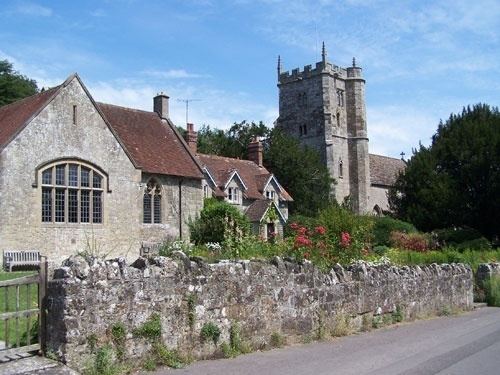Population 681 (in 2011) Civil parish East Knoyle Dialling code 01747 | OS grid reference ST881305 Unitary authority | |
 | ||
East Knoyle is a village and civil parish in Wiltshire, in the south west of England. The village lies just west of the A350 road about 9 miles (14 km) south of Warminster and 5 miles (8 km) north of Shaftesbury, Dorset. It is the birthplace of Sir Christopher Wren.
Contents
- Map of East Knoyle Salisbury UK
- History
- Parish church
- Knoyle Place
- Clouds House
- Governance
- Amenities
- Notable people
- References
Map of East Knoyle, Salisbury, UK
The parish includes the hamlets of Holloway, Milton, The Green, Underhill and Upton.
History
East Knoyle was part of the ancient Hundred of Downton.
Unusually for England, parish registers survive from 1538 and are kept in the Wiltshire and Swindon History Centre.
John Marius Wilson's Imperial Gazetteer of England and Wales (1870-1872) notes two tythings in East Knoyle: Milton and Upton.
East Knoyle's population has risen and fallen in recent centuries, with a period of growth in the 19th century. In 1801 the population was 853, and by 1831 it had reached 1028, but in 1901 it was down again to 814. In 1951, the population was still at 821, but by 1971 it was only 699.
The market town of Hindon was established in the northeast of East Knoyle parish in the early 13th century; Hindon became a separate civil parish in the later 19th century. In 1885 the southern part of the former parish of Pertwood was added to East Knoyle. Most of this portion was transferred to Chicklade parish in 1986.
Primitive Methodists built a chapel, later called Ebenezer chapel, at The Green in 1843; this closed sometime before 1977. Charles Jupe, a silk manufacturer of Mere, built a Congregational chapel and schoolroom in the village in 1854, replacing an earlier chapel. By 1987 the church had fallen into disuse.
The school next to the Congregational church became a British School. A National School was built on land provided by Alfred Seymour, near the church, in 1872-3 with windows in Moorish style. The British School closed in 1881 and the remaining school continued in use until 1984.
The Warminster-Shaftesbury road ran through East Knoyle village. In the 20th century this became part of the A350 primary route between the M4 motorway and the south coast, and took a straighter course to the east of the village.
Parish church
The Church of England parish church of St Mary began before the 1066 conquest. Pevsner described its chancel as "Norman in its bones" and wrote that its 17th-century plaster decoration, a "surprise and delight", "ought to be the purpose of a visit from every Wiltshire tourist".
The church was extended in the 13th, 14th and 15th centuries, with a large tower added in the 15th. Plasterwork in the chancel, depicting biblical scenes, was designed by Dean Christopher Wren (father of prolific architect Sir Christopher Wren) c. 1639. Five of the six bells are from the 18th century. The building was further extended in the 19th century, along with restoration in 1845 by Wyatt and Brandon, and interior alterations in 1875-6 by Sir Arthur Blomfield.
The church was designated as Grade I listed in 1966. Since 2008, the parish has formed part of the benefice of St Bartholomew, a grouping of six parishes.
St Mary's had a chapelry at Hindon from the 13th century. Hindon became a separate vicarage in 1869.
Knoyle Place
Knoyle Place served as the rectory until the 1940s. A 14th-century range, rebuilt in the 17th, stands next to a larger five-bay 18th-century range faced with ashlar.
Clouds House
Clouds House, a Grade II* listed country house northwest of East Knoyle village, was built in 1886-91 to designs of Philip Webb for Percy Wyndham and is one of Webb's grandest designs. It is now occupied by the Action on Addiction charity as a treatment centre for drug and alcohol dependence.
Governance
East Knoyle elects a consultative parish council, while Wiltshire Council have their offices in Trowbridge. The village is represented in Parliament by the member for South West Wiltshire, Andrew Murrison.
The village falls in the 'Nadder and East Knoyle' electoral ward. The ward stretches east-west starting at Burcombe Without and crossing to East Knoyle before stretching south to Donhead St Mary. The total ward population taken at the 2011 census was 4,257.
Amenities
East Knoyle has a village hall, between the church and the former school. It was created in 1908 by the Seymour family, using a 14th-century hall house for one part.
The village has a community-owned shop and post office. There is a pub at The Green, the Fox and Hounds.
Notable people
The architect Sir Christopher Wren was born at East Knoyle on 20 October 1632.
A branch of the Seymour family held land at East Knoyle, including three Members of Parliament: Henry (d. 1807), Henry (d. 1849) and Alfred (d. 1888). They had a 17th-century house, Knoyle House, east of the church and beside the Warminster-Shaftesbury road; the house was demolished in 1954.
The author Joan Wyndham (1921–2007) was born in the village.
